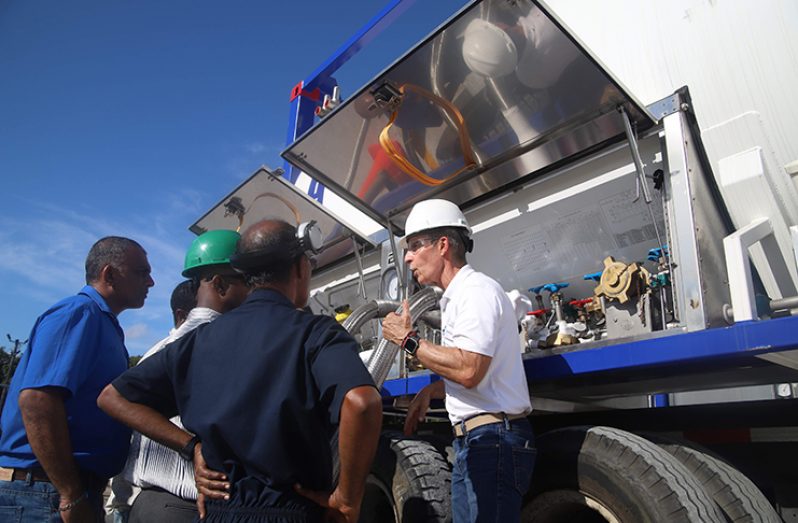-commissions LNG regasification terminal at Diamond
AS part of Demerara Distillers Limited’s (DDL’s) drive to employ clean-energy sources for its power generation, the company recently commissioned Guyana’s first LNG regasification terminal at its compound at Plantation Diamond and is now using LNG to power its operations.
In a statement on Sunday, DDL explained that Liquefied Natural Gas (LNG) is natural gas that has been chilled to minus 160 Celsius, turning into a liquid, thereby making it safe to load and transport in specially-designed containers. When warmed back to atmospheric temperature at DDL’s regasification terminal, the LNG becomes natural gas and is used to power electric generators and boilers. When used for power generation, natural gas emits significantly less carbon dioxide (CO2), fewer sulphur and nitrogen oxides, and almost zero particulate matter, making it the cleanest of all fossil fuels. Working with its Trinidad-based LNG fuel supplier, ICON LNG Trinidad Limited, DDL converted a pair of its diesel generators to dual-fuel, which are powered on a mixture of natural gas and diesel, thus helping it become one of Guyana’s cleanest power producing companies.
“We are very excited to be the first Guyanese company to use LNG for our power generation needs,” said DDL’s Chief Finance Officer, Mr. Vasudeo Singh.
“As part of our efforts to diversify our fuel supply to cleaner alternatives, we studied the options and concluded that LNG or natural gas is a safe and proven fuel globally as well as here in the Caribbean region where it is being used extensively in Jamaica, Barbados and the Dominican Republic in operations similar to ours. We are also pleased to partner with ICON LNG who provided us a turnkey equipment and supply solution for regular LNG deliveries,” Singh added.
To support the LNG operations, DDL also recently held a full-day training seminar for a number of its employees covering LNG awareness and safe handling procedures. The training course was conducted by experienced health and safety instructor, Mark Superville, of Safety Pass Alliance Trinidad and Tobago (SPATT) Limited.
The course covered a range of critical topics including the properties of LNG, LNG tank design, loading and unloading procedures, required personal protective equipment and spill response procedures. Also included in the training was a hands-on curriculum at DDL’s regasification terminal where attendees became familiar with the operational controls of the LNG tanks as well as the proper procedures for connecting and disconnecting the tanks to the regasification terminal. Port personnel and truck operators from John Fernandes Ltd also attended the training seminar.
The establishment of the LNG regasification terminal at DDL’s Diamond Compound comes approximately three years after the International Monetary Fund (IMF) opined that investment in LNG plants here in Guyana can rake in must-needed finance.
It was the IMF then Executive Director, Otaviano Canuto, who had made the preposition in 2016, noting that the plant could be used to refine the gas.
During the first round of training in 2016, then Minister of Business, Dominic Gaskin, said the pilot project undertaken by ICON LNG and DDL provide useful information, thereby increasing the business community’s understanding of various options that are available to address some of the needs.
“In this case, we are looking at the need for reliable, affordable and clean energy,” he said, while alluding to the current challenges facing Guyana due its inability to competitively produce for the global market.
“Our failure so far to develop a competitive manufacturing industry usually speaks of the lack of affordable and reliable energy as one of the main causes,” the then Minister had said.
Notably, the establishment of the LNG regasification terminal is in keeping with the government’s vision and plans to transition to almost 100 per cent renewable energy generation by 2040. Such a move is expected to allow for a more reliable and stable grid and creation of a massive dent in the country’s fuel import bill.
Currently, approximately 18 per cent of the country’s primary energy supply is derived from renewable energy – predominantly in the form of bagasse, firewood and solar PV, while the remaining 82 per cent of primary energy supply is sourced from imported fossil fuel – primarily diesel, heavy fuel oil and gasoline.
On average, approximately 1,836,300 barrels of fossil fuel are used to generate electricity annually, and translates to an estimated US$139.30 million on a yearly basis, based on the average consumption between 2015 to 2018.
However, while Guyana’s energy demand, driven by population growth and economic development, is projected to increase, it is anticipated that as the country transitions to nearly 100 per cent of renewable energy by 2040 in keeping with its Green State Development Strategy: Vision2040 (GSDS: Vision2040), fewer financial resources would be expended on the importation of fossil fuel.




.png)









